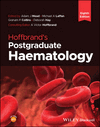Application of next-generation sequencing in haematology
Angela Hamblin
Department of Haematology, Oxford University Hospitals NHS Foundation Trust, Oxford, United Kingdom
Nuffield Department of Orthopaedics, Rheumatology & Musculoskeletal Sciences, Oxford University, Oxford, United Kingdom
Search for more papers by this authorAdele Timbs
Oxford Genetics Laboratories, Oxford University Hospitals NHS Foundation Trust, Oxford, United Kingdom
Search for more papers by this authorAngela Hamblin
Department of Haematology, Oxford University Hospitals NHS Foundation Trust, Oxford, United Kingdom
Nuffield Department of Orthopaedics, Rheumatology & Musculoskeletal Sciences, Oxford University, Oxford, United Kingdom
Search for more papers by this authorAdele Timbs
Oxford Genetics Laboratories, Oxford University Hospitals NHS Foundation Trust, Oxford, United Kingdom
Search for more papers by this authorAdam J Mead PhD, FRCP, FRCPath, FMedSci
Haematopoietic Stem Cell Biology Laboratory, Medical Research Council Molecular Haematology Unit, Medical Research Council Weatherall Institute of Molecular Medicine, University of Oxford, Oxford, UK
Search for more papers by this authorMichael A Laffan DM, MRCP, FRCPath
Department of Immunology and Inflammation, Faculty of Medicine, Imperial College London, London, UK
Search for more papers by this authorGraham P Collins DPhil, FRCP, FRCPath
Department of Haematology, Oxford Cancer and Haematology Centre, Oxford, UK
Search for more papers by this authorDeborah Hay DPhil, MRCP, FRCPath
Nuffield Division of Clinical Laboratory Sciences, Radcliffe Department of Medicine, University of Oxford, Oxford, UK
Search for more papers by this authorA Victor Hoffbrand MA, DM, FRCP, FRCPath, FRCP (Edin), DSc, FMedSci
Emeritus Professor of Haematology Honorary Consultant Haematologist
University College London, London, UK
Royal Free Hospital, London, UK
Search for more papers by this authorSummary
For over 60 years since the discovery of the Philadelphia chromosome, the role of genomics in haematological diseases has been evident. With the advent of Next- Generation Sequencing (NGS), which allows large regions of multiple individuals’ genomes to be analysed simultaneously, the option of undertaking more comprehensive genomic testing in both malignant and non-malignant haematological disorders has become both practical and affordable. The chapter ‘Application of Next- Generation Sequencing in Haematology’ explores the available sequencing assays, required bioinformatics and variant interpretation as well as the clinical utility and practical considerations of this new technology.
Selected bibliography
- Duncavage EJ , Schroeder MC , O'Laughlin M et al . ( 2021 ) Genome sequencing as an alternative to cytogenetic analysis in myeloid cancers . New England Journal of Medicine 384 ( 10 ): 924 – 35 . https://doi.org/10.1056/nejmoa2024534 .
-
Horak P
,
Griffith M
,
Danos AM
et al
. (
2022
)
Standards for the classification of pathogenicity of somatic variants in cancer (oncogenicity): joint recommendations of Clinical Genome Resource (ClinGen), Cancer Genomics Consortium (CGC), and Variant Interpretation for Cancer Consortium (VICC)
.
Genetics in Medicine.
https://doi.org/10.1016/j.gim.2022.01.001
.
10.1016/j.gim.2022.07.001 Google Scholar
- Logsdon GA , Vollger MR , Eichler EE ( 2020 ) Long-read human genome sequencing and its applications . Nature Reviews Genetics 21 ( 10 ): 597 – 614 . https://doi.org/10.1038/s41576-020-0236-x .
- Richards S , Aziz N , Bale S et al . ACMG Laboratory Quality Assurance Committee ( 2015 ) Standards and guidelines for the interpretation of sequence variants: a joint consensus recommendation of the American College of Medical Genetics and Genomics and the Association for Molecular Pathology . Genetics in Medicine: Official Journal of the American College of Medical Genetics 17 ( 5 ): 405 – 24 . https://doi.org/10.1038/gim.2015.30 .
- Roy N , Da Costa L , Russo R et al . ( 2022 ) The use of next-generation sequencing in the diagnosis of rare inherited anaemias: a joint BSH/EHA good practice paper* . British Journal of Haematology 198 ( 3 ): 459 – 77 . https://doi.org/10.1111/bjh.18191 .
- Roy S , Coldren C , Karunamurthy A et al . ( 2018 ) Standards and guidelines for validating next-generation sequencing bioinformatics pipelines: a joint recommendation of the association for molecular pathology and the college of american pathologists . The Journal of Molecular Diagnostics: JMD 20 ( 1 ): 4 – 27 . https://doi.org/10.1016/j.jmoldx.2017.11.003 .
-
Ryan SL
,
Peden JF
,
Kingsbury Z
et al
. (
2023
)
Whole genome sequencing provides comprehensive genetic testing in childhood B-cell acute lymphoblastic leukaemia
.
Leukemia
1
–
11
.
https://doi.org/10.1038/s41375-022-01806-8
.
10.1038/s41375?022?01806?8 Google Scholar
- Shendure J , Balasubramanian S , Church GM et al . ( 2017 ) DNA sequencing at 40: past, present and future . Nature 550 ( 7676 ): 345 – 53 . https://doi.org/10.1038/nature24286 .
- Speight B , Hanson H , Turnbull C et al . Consensus Meeting Attendees ( 2023 ) Germline predisposition to haematological malignancies: best practice consensus guidelines from the UK Cancer Genetics Group (UKCGG), CanGene-CanVar and the NHS England Haematological Oncology Working Group . British Journal of Haematology 201 ( 1 ): 25 – 34 . https://doi.org/10.1111/bjh.18675 .
- Stark R , Grzelak M , Hadfield J ( 2019 ) RNA sequencing: the teenage years . Nature Reviews Genetics 20 ( 11 ): 631 – 56 . https://doi.org/10.1038/s41576-019-0150-2 .



